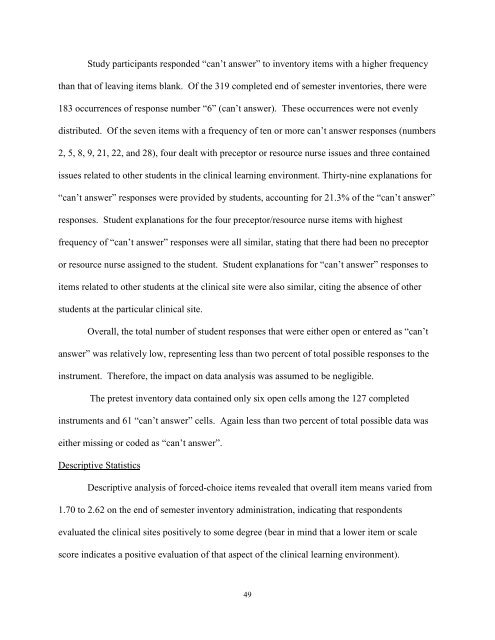STUDENT EVALUATION OF CLINICAL EDUCATION ENVIRONMENT
STUDENT EVALUATION OF CLINICAL EDUCATION ENVIRONMENT
STUDENT EVALUATION OF CLINICAL EDUCATION ENVIRONMENT
Create successful ePaper yourself
Turn your PDF publications into a flip-book with our unique Google optimized e-Paper software.
Study participants responded “can’t answer” to inventory items with a higher frequency<br />
than that of leaving items blank. Of the 319 completed end of semester inventories, there were<br />
183 occurrences of response number “6” (can’t answer). These occurrences were not evenly<br />
distributed. Of the seven items with a frequency of ten or more can’t answer responses (numbers<br />
2, 5, 8, 9, 21, 22, and 28), four dealt with preceptor or resource nurse issues and three contained<br />
issues related to other students in the clinical learning environment. Thirty-nine explanations for<br />
“can’t answer” responses were provided by students, accounting for 21.3% of the “can’t answer”<br />
responses. Student explanations for the four preceptor/resource nurse items with highest<br />
frequency of “can’t answer” responses were all similar, stating that there had been no preceptor<br />
or resource nurse assigned to the student. Student explanations for “can’t answer” responses to<br />
items related to other students at the clinical site were also similar, citing the absence of other<br />
students at the particular clinical site.<br />
Overall, the total number of student responses that were either open or entered as “can’t<br />
answer” was relatively low, representing less than two percent of total possible responses to the<br />
instrument. Therefore, the impact on data analysis was assumed to be negligible.<br />
The pretest inventory data contained only six open cells among the 127 completed<br />
instruments and 61 “can’t answer” cells. Again less than two percent of total possible data was<br />
either missing or coded as “can’t answer”.<br />
Descriptive Statistics<br />
Descriptive analysis of forced-choice items revealed that overall item means varied from<br />
1.70 to 2.62 on the end of semester inventory administration, indicating that respondents<br />
evaluated the clinical sites positively to some degree (bear in mind that a lower item or scale<br />
score indicates a positive evaluation of that aspect of the clinical learning environment).<br />
49












